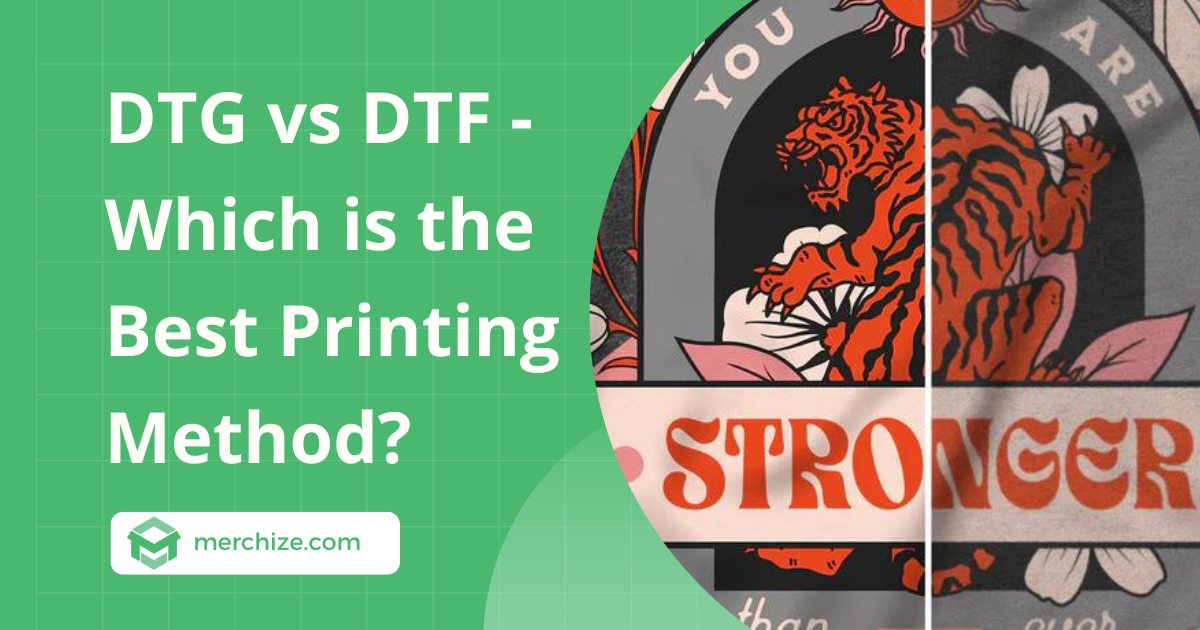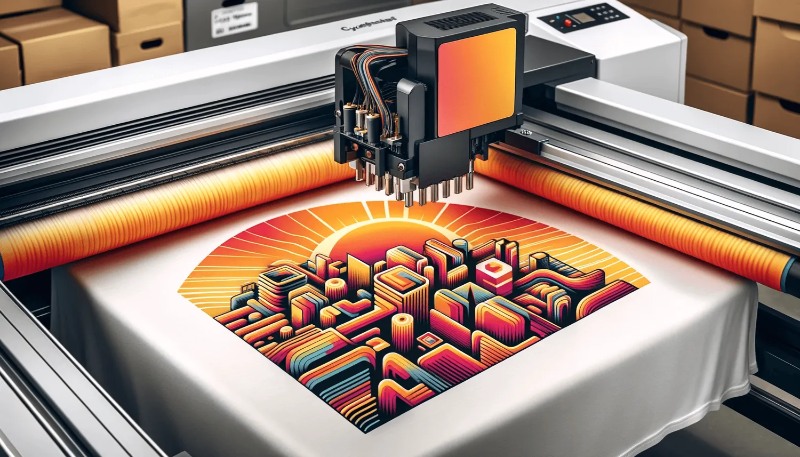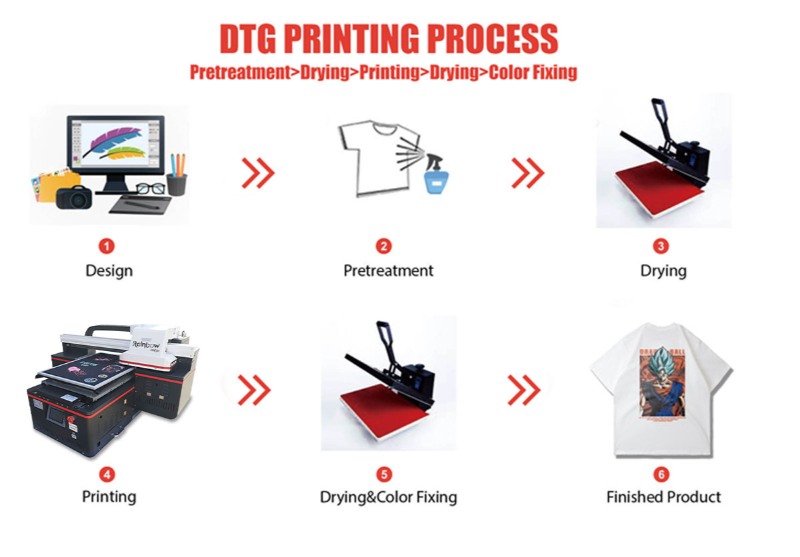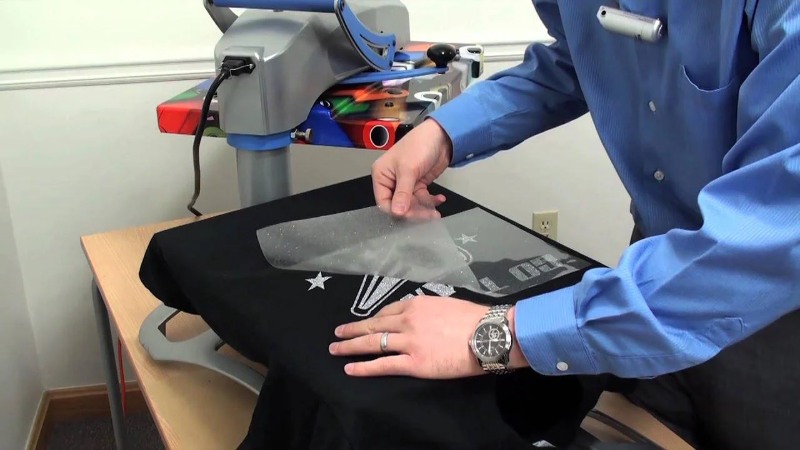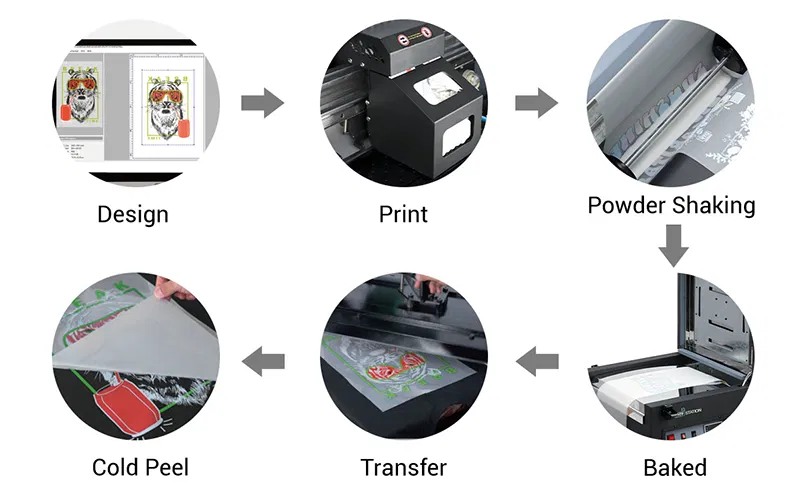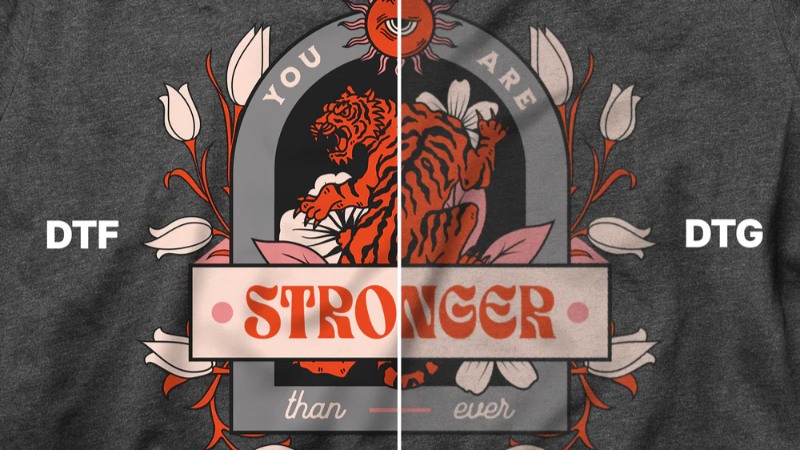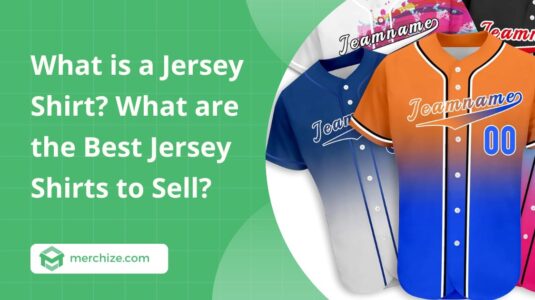Contents
DTG and DTF are among the most popular printing methods for apparel. To find the best printing methods for your designs, you must understand the differences between these two printing options. In this blog post, we’ll dive into the pros, cons, and key differences of each technique, helping you make an informed decision. Read on to discover which one will take your designs to the next level!
DTF vs DTG: Short Comparison
| Aspect | DTG (Direct-to-Garment) | DTF (Direct-to-Film) |
| Cost-effectiveness | Better for small orders due to no setup costs. However, ink costs can increase with large volumes. | More cost-effective for bulk orders as it uses less ink and involves an efficient transfer process. |
| Order Volume | Ideal for one-off or low-volume orders with direct printing onto fabric. | Suitable for small and large orders; faster for bulk production as designs can be pre-printed on film. |
| Print Quality | Produces highly detailed, smooth prints with excellent gradients; soft and integrated feel. | Vibrant, bold colors with good detail but slightly textured; prints sit on the fabric surface. |
| Hand Feeling | Soft and lightweight; feels like part of the fabric. | Slightly raised and textured; can feel stiff for large prints and reduce fabric stretchability. |
| Design Complexity | Excellent for intricate, high-resolution designs like watercolor or photographic prints. | Handles bold and multi-color designs well but struggles with ultra-fine details and gradients. |
| Fabric Compatibility | Best on cotton or cotton-blend fabrics; struggles with synthetics. | Compatible with a wide range of fabrics, including cotton, polyester, blends, and even non-fabric materials. |
| Durability | Integrated prints resist cracking and fading longer. | Durable but prone to cracking and fading as prints sit on the fabric surface. |
| Turnaround Time | Faster for small or custom orders due to direct printing; pre-treating and curing add time. | Slower for one-off orders but efficient for bulk production with pre-printed designs on film. |
| Who Should Use It | Small businesses or print-on-demand sellers offering custom, high-detail designs on casual apparel. | Businesses handling bulk orders, promotional products, or requiring vibrant prints on diverse materials |
What is DTG printing?
DTG, or Direct-to-Garment printing, is a method used to print designs directly onto t-shirts and other clothing, without additional tools like stencils, screens, or transfer papers. Similar to how you can use a regular printer to print a picture directly on paper, but instead of paper, you’re printing on fabric, and instead of a regular printer, you use a dedicated DTG printer.
To achieve soft and smooth finish prints, DTG printers use water-based ink that absorbs directly into the fibers of the fabric. DTG is popular in print-on-demand since they are great for one-time printing and cost-effective in creating full-color, high-quality print.
To have a thorough understanding of these printing methods and all their pros and cons, read our in-depth blog about Direct-To-Garment Printing and how it works.
How DTG Works:
- Prepare design: First, you create or choose a design on a computer. This can be anything—text, an image, or a mix of both.
- Pretreatment: The garment, usually made of cotton or a cotton blend, is pre-treated with a special solution that helps the ink bond with the fabric. This step is critical for vibrant colors and durable prints, especially on darker fabrics.
- Load the item: The t-shirt (or another piece of clothing) is placed onto a special tray in the DTG printer, flat and smooth, so the design can be printed evenly.
- Print: The DTG printer uses special water-based inks to print the design directly onto the fabric. The printer sprays the ink onto the shirt, just like a paper printer sprays ink onto paper. These inks are absorbed into the fabric, giving a smooth and soft finish.
- Cure printing: After printing, the shirt is placed under a heat press or in a dryer. This step helps the ink dry and set properly so the design stays in place even after washing.
>>> Also read: DTG vs Screen Printing: Which one is the best choice?
Why It’s Popular:
- No setup for small orders: You can print just one shirt or many, and it doesn’t require a lot of preparation.
- High detail: It’s perfect for complex designs with lots of colors or fine details.
- Custom designs: Each shirt can be printed with a unique design without extra costs.
DTG is commonly used for print-on-demand businesses, where people order custom shirts one at a time. At Merchize, we currently use DTG printing for a whole range of apparel products to provide the best printing quality at an affordable price.
What is DTF Printing?
Compared to DTF, DTF is relatively new. However, this printing method is seeing an uptick in terms of popularity thanks to the many benefits and advantages it brings. DTF is excellent in bringing out the vibrancy in colors and precision in details. Other than high-quality printing, DTF also excels in many aspects: durability, low product cost, and high compatibility with various materials.
DTF, or Direct-to-Film printing, is a type of heat transfer printing method. Similar to traditional heat transfer printing, DTF requires printing on a transfer paper first, then transferring this printing from the paper to the fabric surface under high temperature and pressure.
What makes DTF different is that it uses a special power as an adhesive agent. It’s like a type of heat-activated glue. This power melts under the heat and bonds the prints with the printing surface.
How DTF Works:
- Design Creation: First, a design is created on a computer. It can be a logo, image, or text, just like with DTG or other printing methods.
- Printing on Film: The design is printed onto a special transfer film using a DTF printer. This printer uses special inks, including white ink, which helps the design stand out on dark fabrics. The design is printed in reverse (like a mirror image) on the film.
- Adding Powder: A special adhesive powder is applied to the printed design while the ink is still wet. This powder sticks to the design and will help it bond to the fabric.
- Curing the Powder: The film with the powder is heated to dry and activate the adhesive. This step prepares the design for transfer.
- Transferring to Fabric: The printed film is placed on the fabric with the design facing down, and then pressed onto the fabric using a heat press. The heat melts the adhesive powder, which sticks the design to the fabric.
- Peeling the Film: Once the transfer is complete, the film is peeled away, leaving the design on the fabric.
Why It’s Popular:
- Works on many fabrics: DTF can be used on a variety of materials like cotton, polyester, blends, and more.
- Durable prints: The designs last through many washes without cracking or fading.
- Bright colors on dark fabrics: Because it uses white ink as a base, designs stand out on dark-colored clothes.
DTG vs DTF: Detailed Comparison
1. Cost-effectiveness:
- DTG: Generally more cost-effective for small orders because it doesn’t require complex setups. You won’t have to purchase extra materials like films to print a product. However, DTG inks are typically expensive, especially if you’re printing detailed, full-color designs. This can increase the cost when you’re printing larger volumes.
- DTF: More cost-effective for larger orders as it requires less ink, and the transfer process can be more efficient. DTF uses less ink than DTG since the ink doesn’t have to absorb deeply into the fabric; it stays on the surface. This lowers the overall cost per print, especially for large batches.
Who should use DTG? If you run a small online store offering personalized t-shirts where each customer orders one or two unique designs, DTG is perfect. You save on setup costs because you’re printing directly onto the fabric.
Who should use DTF? If you’re fulfilling a large order for a sports team that wants 100+ t-shirts with the same logo, DTF can save you on costs, especially in ink and materials.
2. Order Volume:
- DTG: The lack of setup means that DTG is perfect for one-off orders. You can print each design directly onto the garment without needing to prepare transfer films or screens. It’s best suited for low-volume, on-demand printing where customization is key. It’s popular for print-on-demand services, allowing for items at a time.
- DTF: Works well for both small and large orders, but is more efficient for bulk orders since designs can be printed and transferred quickly in larger quantities. You can print multiple designs onto film sheets in advance and then quickly transfer those designs onto various garments. The transfer process with heat is faster, so for big batches, this method becomes much more efficient.
Who should use DTG? Print on demand sellers or small business owners could benefit from DTG to produce customized, unique items.
Who should use DTF? Suitable for larger bulk printing orders. If you are printing uniforms, promotional products, or merch in large volume, DTF can save you on costs, especially in ink and materials.
3. Print Quality:
- DTG produces highly detailed prints with a smooth finish and excellent color gradients, especially on light-colored garments. The print feels soft and integrated into the fabric as the ink is absorbed directly into the fabric fibers
- DTF: The quality is good with vibrant colors and crisp details, but it may not be as precise in detail as DTG. The print may feel slightly more textured compared to DTG since it sits on the surface of the fabric. This can create a slightly raised texture. In addition, the adhesive powder used in DTF adds durability but can also result in a thicker, more noticeable print surface.
If you prefer bold, colorful graphic t-shirts, you should use would find DTF effective because the method can handle multi-color designs on dark fabrics without requiring pre-treatment, though the print will feel thicker than DTG.
On the other hand, DTG works better with designs that require a high level of precision and detail. Besides, DTG is more suitable for printing vintage, retro designs, as DTG colors are more muted and don’t pop as much as DTF prints do.
4. Hand feeling
- DTG: The design feels soft and lightweight on the fabric, almost like it’s absorbed into the shirt.
- DTF: The print feels slightly raised and textured, more like a vinyl or sticker. While durable, it doesn’t integrate into the fabric as smoothly as DTG. For large printing, it might cause the fabric to lose its stretchability and softness.
Hand feeling is a distinctive feature that can tell these two printing techniques apart. When selecting the right printing method, think about whether you prefer the soft and flowy fabric of DTG or the bold and vibrant but slightly textured and stiff prints of DTF.
5. Design Complexity:
- DTG: Ideal for complex designs with many colors, gradients, and intricate details. It can handle high-resolution images, including photographs. For example, a shop that sells artistic t-shirts with watercolor-style designs would prefer DTG since it can reproduce the soft transitions between colors and delicate lines.
- DTF: Works well for multi-color designs and can transfer detailed images, but may not handle complex gradients or ultra-fine details as smoothly as DTG. The transfer process makes it challenging to handle very fine details, as the film may not capture these as accurately as DTG.
If printing quality and precision are your top priorities, then DTG is a better choice. It can preserve your intricate designs and portray them in a good light. But in case your designs are simple and bold, DTF is more suitable as it works well in highlighting the bold colors and details.
6. Fabric Compatibility:
- DTG: Works best on cotton or cotton-blend fabrics. The ink needs to bond with the fabric fibers to create a durable print, and synthetic materials like polyester do not absorb the ink well, resulting in lower print quality.
- DTF: Can be used on a wider range of fabrics, including cotton, polyester, blends, and even non-fabric materials like leather. This versatility makes DTF more adaptable for different garment types.
The versatility of DTF makes it an ideal printing option for businesses with larger categories and various product lines and materials. But if you just want to focus on selling casual, simple, everyday clothing items like T-shirts or Hoodies, you can stick to DTG.
7. Durability and Washability
When it comes to durability, DTG and DTF are on par with each other. Botch can provide long-lasting, durable print. However, due to the difference in printing technique, DTG has a small edge over DTF in terms of print longevity.
- DTG: The print is integrated into the fabric, which gives it a soft feel and makes it more resistant to cracking or fading.
- DTF: DTF prints don’t blend well with the fabric like DTG. It just sits on the material surface, which makes it more prone to cracking and fading over time.
8. Turnaround Time
Turnaround time is crucial in production. The longer it takes, the costlier it gets. When it comes to customization orders, the turnaround time could affect customer satisfaction and can be used as a competitive advantage over other businesses.
- DTG: Faster for small, on-demand orders because there’s no need to print and transfer. Especially with on-off, personalized design, the simple printing process makes it more efficient. However, DTG requires additional pre-treating and curing processes to ensure the print’s quality, which extends the process a bit longer.
- DTF: Can be slower for individual orders since there’s an extra step of transferring the design from film to fabric. However, for bulk orders, DTF can speed up as designs can be pre-printed on film and applied in batches.
To optimize the production time, you should decide based on the printing quantity. For smaller orders or customized orders, DTG can help you speed up the process. With DTF, you can save more time with bulk orders.
Both DTF and DTG printing offer unique advantages depending on your business needs. If you’re looking for high-quality, detailed prints for small or custom orders, DTG is your go-to. For larger, vibrant, and versatile bulk orders, DTF is the more efficient choice. The key is understanding which method aligns with your goals.
DTF vs DTG: Which Designs Work Best for Each Method?
After understanding how DTF and DTG printing work, it can be seen that both produce high-quality prints and are suitable for the print-on-demand business. However, each technology has different printing characteristics. Therefore, if you choose the wrong one, your design may be degraded or lose the desired effect. Below is a detailed analysis to help you choose the right technology for each type of design.
When Should You Choose DTF Printing?
- Suitable materials: DTF is the most powerful weapon when printing on polyester, nylon, felt, synthetic fabrics, and even canvas bags, baseball caps, and backpacks. This helps you expand your product portfolio easily.
- Design advantages: DTF handles multi-color images, complex color transitions, and small details extremely well. The colors are always fresh, bold, and sharp.
- Durability: The DTF print adheres firmly, is difficult to peel off, and retains color well through many washes.
- Limitations: If you print a large, solid area (full coverage print), the surface will feel thick and less breathable, sometimes a bit like a thin layer of plastic. This can be uncomfortable to wear, especially with light shirts or clothes worn close to the skin.
- Tips: Before mass production, print a sample to check the wearing feel and print quality compared to other methods.
When Should You Choose DTG Printing?
- Suitable materials: DTG prints best on 100% cotton or cotton blends. In addition to T-shirts, you can print on hoodies, sweaters, tote bags, and many other natural fiber products.
- Design advantages: DTG is ideal for simple designs such as letters, logos, and basic shapes. However, DTG can still print photos and multi-color designs, just that the sharpness is not as good as DTF when zooming in on details.
- Durability & feel: The ink layer penetrates directly into the fabric fibers, giving a soft, light, and breathable feel. Very suitable for large-sized prints on shirts.
- Reliability: This is one of the most widely used printing techniques in the world, with little risk of quality loss. Just follow the washing instructions, and the print will be durable for a long time.
- Tips: If your main product is a fashionable cotton shirt and you want your customers to feel comfortable, DTG is a safe and effective choice.
FAQs
Do DTF prints last longer than DTG?
Yes, DTF prints often outlast DTG due to their durability and resistance to fading, cracking, and washing wear. DTG prints, while vibrant and soft, are more prone to wear over time, especially with improper care.
Can DTG printers be used for DTF printing?
Yes, many DTG printers can be modified for DTF printing. However, this requires specific adjustments, such as using DTF inks and powders and reconfiguring the printer settings for optimal performance.
Which printing method is better for detailed designs: DTF or DTG?
DTG excels in capturing fine details and gradients, making it ideal for intricate, high-resolution designs. DTF is also detailed but may slightly struggle with ultra-fine lines or photographic prints due to its powder adhesive process.
Is DTF printing suitable for dark fabrics?
Absolutely! DTF printing works exceptionally well on dark fabrics. The white underbase layer provides vibrant and opaque results, even on the darkest materials.
Can DTG print on polyester or other synthetic fabrics?
Yes, but with limitations. DTG printing works best on 100% cotton. Printing on polyester or synthetic blends often requires pretreatments and might result in less vibrant prints compared to cotton.
Which method has a faster production time: DTF or DTG?
DTF typically has a faster workflow, especially for bulk orders. The transfer process allows designs to be pre-prepared and applied quickly, whereas DTG requires more setup time, including pretreatment and curing.
Is DTF printing more eco-friendly than DTG?
DTG is generally more eco-friendly due to its water-based inks and lack of additional adhesive powders. DTF involves extra materials, like PET film and adhesive powders, which increase waste.
Do DTF printing transfers crack?
If properly applied, DTF prints are flexible and resistant to cracking. However, poor-quality films, adhesives, or improper heat press settings can lead to cracks over time.
Are DTF and DTG inks the same?
No, DTF inks are designed specifically for transfer processes and require adhesive powders, whereas DTG inks are formulated to bond directly with fabric fibers during printing.
Which is cheaper: DTF or DTG?
DTF is generally cheaper for small batches or complex designs on varied fabric types due to its versatility and lower setup costs. DTG may be more cost-effective for large runs of cotton-based garments due to faster direct printing.
